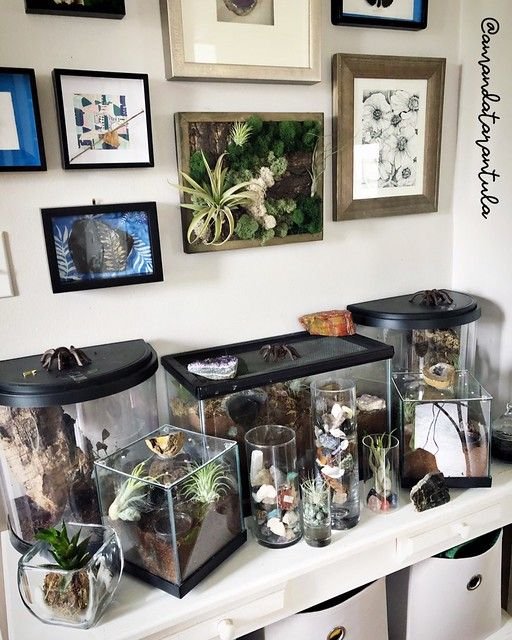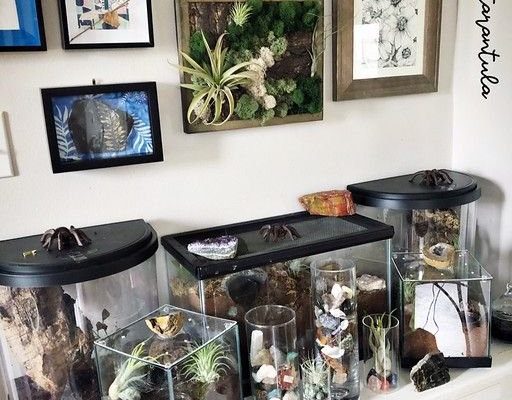
Creating a terrarium isn’t just about aesthetics; it’s about building a healthy habitat where your tarantula can thrive. The right setup will not only mimic its natural environment but also make your job as a caretaker a lot easier. If you’re just starting out in the world of tarantulas, don’t worry—I’m here to guide you through it step by step, like a friendly barista sharing the secrets to your favorite brew.
Choosing the Right Terrarium
When it comes to housing your cobalt blue tarantula, the first thing you need to consider is the terrarium size. Honestly, a 10-gallon tank is a great starting point for a single tarantula. It offers ample space for them to roam and create little hideouts. You might be wondering if you can get away with a smaller terrarium. While it might seem tempting, remember that this species loves to explore!
You also need to think about the material of the terrarium. Glass and acrylic are popular choices because they offer good visibility and insulation. Glass terrariums are sturdy and provide better ventilation when set up correctly. On the other hand, acrylic tanks tend to be lighter and less prone to breaking, making them easier to handle.
Also, ensure your terrarium has a secure lid. Cobalt blue tarantulas are surprisingly agile and can climb quite well, so a well-fitted lid will keep your pet safe and sound.
Creating a Suitable Substrate
The *substrate* is the foundation of your tarantula’s home, and it plays a vital role in its overall health. For the cobalt blue tarantula, you want a substrate that retains moisture but also allows for good drainage. A mix of peat moss and coconut fiber works wonders. This combination keeps the humidity at optimal levels while giving your spider some texture to burrow into.
Aim for a substrate depth of about 3 to 5 inches. This depth allows your tarantula to dig and express its natural behavior—something that’s super important for its well-being. You might be surprised at how much they enjoy creating little nooks and crannies!
Don’t forget to occasionally check the moisture levels in the substrate. A simple spritz of water in the morning can help maintain the right humidity, but avoid soaking it completely.
Setting Up Hiding Spots
Believe me, your cobalt blue tarantula will appreciate having hiding spots in its terrarium. These cozy corners give them a sense of security and help reduce stress. You can use small cork bark, plant pots, or even commercially available tarantula hides. Just make sure these hides are stable and won’t topple over when your pet goes in or out!
Position the hides near the substrate to allow for easy access. You can even create a little “wilderness” vibe by placing some dried leaves or moss around them. This not only enhances the aesthetics but also mimics the tarantula’s natural habitat, providing both comfort and cover.
Also, avoid overcrowding the terrarium. While it’s tempting to add numerous decor pieces, remember that your tarantula needs space to roam and explore. A few well-placed hides will do just fine.
Maintaining Proper Humidity and Temperature
The cobalt blue tarantula thrives in humidity levels of around 75-80%. To achieve this, using a hygrometer can be really helpful. This handy tool will tell you if the humidity is in the right range. If you find that it’s low, a simple misting of the substrate a couple of times a week can help. Just be careful not to overdo it; soggy substrate isn’t healthy for your tarantula.
As for the temperature, keeping the environment between 75°F and 80°F is ideal. You can achieve this with a heating pad or lamp. If you decide to use a heat source, place it on one side of the tank, allowing your tarantula to choose its preferred temperature. *Here’s the thing*: tarantulas are good at regulating their body temperature, so providing a gradient ensures they can move to a spot that feels best for them.
Feeding Your Cobalt Blue Tarantula
Feeding a cobalt blue tarantula is one of the more exciting aspects of keeping them. These spiders are carnivorous, feasting mainly on insects. Common choices include crickets, roaches, and mealworms. When determining how much to feed, keep in mind the size of your tarantula; it should be no larger than the width of its carapace.
You might wonder how often to feed them—generally, once every week or two is sufficient, depending on the spider’s age and size. Juveniles may eat more frequently, while adults can go longer between meals. Just remember, if your tarantula isn’t interested in food, they might be in a molting phase, so it’s best to hold off feeding until after they’ve shed.
It’s a good idea to remove any uneaten prey after 24 hours to prevent stress or injury to your tarantula.
Lighting and Ventilation Needs
While the cobalt blue tarantula doesn’t require high-intensity lighting, incorporating a low-level light can help you enjoy watching its vibrant colors. You could use a simple LED light to simulate a day/night cycle without disturbing its natural habitat. Just be sure the light isn’t too bright or too hot, as this can cause stress.
When it comes to ventilation, adequate airflow is essential. Most terrariums come with built-in vents, but if yours doesn’t, you might consider drilling small holes near the top of the tank. Proper ventilation helps prevent mold growth and ensures a fresh environment for your tarantula. Just keep an eye on the humidity levels; sometimes, increased ventilation can dry out the substrate.
Common Mistakes to Avoid
Creating the perfect setup for your cobalt blue tarantula is a learning process, and everyone makes mistakes along the way. One common pitfall is over-watering the substrate. You want it to be moist but not soaked. If you notice a foul smell or excess water, it’s time to rethink your watering schedule.
Another mistake is failing to provide enough space for your tarantula. Crowded terrariums can lead to stress, which can cause health issues. Stick to the essentials and ensure your tarantula has room to move.
Lastly, don’t forget to regularly check on the health of your tarantula. If you notice changes in behavior or appearance, it’s essential to address them promptly. Noticing these signs early can make a significant difference in their health and happiness.
In conclusion, setting up the best terrarium for your cobalt blue tarantula is an exciting journey that requires attention to detail. With the right habitat, you’ll enjoy watching your stunning tarantula thrive, and they will appreciate the effort you’ve put into their home. Remember, every bit of care you provide contributes to their well-being and your joy as a pet owner. Happy tarantula keeping!

